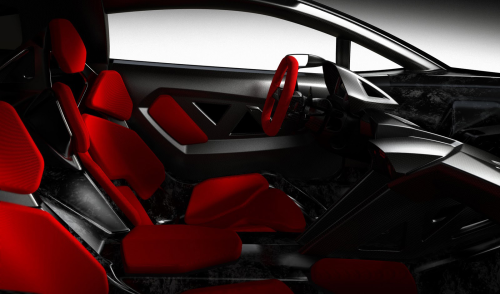

The car is based around a carbon fibre monocoque passenger cell manufactured in a one-shot process.
Connected to the monocoque are the front subframe (incorporating the suspension points) and the crash boxes, both also made of carbon fibre reinforced plastic (CFRP). The rear subframe, with the engine mount and rear axle suspension points, is made from aluminium.
The exterior panels, major suspension components (control arms), the wheels and the drive shaft are also made of CFRP. The tailpipes are made from Pyrosic, an advanced glass-ceramic matrix composite, able to withstand temperatures up to 900°C.
A major benefit of carbon composite is that complex structures can be integrated into a single component. On the Lamborghini Sesto Elemento, the front and rear of the body shell are each manufactured in a single piece. Lamborghini engineers call these 'cofango', a combination of the Italian word 'cofano' (hood) and 'parafango' (fender). Thus, the body shell exterior is made up of the roof section (part of the monocoque), the two front and rear structures (cofango), and the doors. Each door consists of only two elements, the exterior skin and the interior cladding, which are bonded to create one component.
The minimalist approach has also been applied to the interior. Lamborghini has dispensed with the conventional seat frame and the whole internal structure is obtained from the carbon monocoque. The seat cushions are fixed directly to the monocoque. CFRP is visible throughout the interior – on the floor and roof of the monocoque, on the doors and also on the cockpit and centre console.
The Sesto Elemento is finished in a new, matt-shimmer clear coat so that the CFRP structure can be seen throughout. During the final stage of production the carbon fibre parts receive a newly developed and patented coating; nano-technology makes it possible to add fine crystals with a red shimmer.
Production
Lamborghini says it used mainly three composite production processes for the manufacture of the CFRP parts of the Sesto Elemento:
- Forged Composite: a process in which materials with short carbon fibers are hot pressed in a mould. This facilitates the manufacture of complex structures and is used for parts such as the underside of the monocoque and the suspension arms;
- Prepreg: the carbon fibre/thermoset resin prepregs are pressed in moulds and cured in an oven under heat and pressure. Prepreg components have a good surface finish and are preferred for use in visible areas; and
- Braiding: a method to manufacture composite filament derived from the textile industry. Each thread is diagonally intertwined on different levels.
Development of carbon fibre technology
Lamborghini's experience with carbon fibre goes back to 1983, when it produced the first prototype CFRP chassis for the Countach, with the first series production parts appearing in 1985. The current Lamborghini Murciélago is made largely from CFRP – its body-in-white contains 93 kg of carbon fibre materials. The company says the engine cover panel of the Gallardo Spyder is one of the largest CFRP components with Class A surface quality in the automotive world.
Lamborghini drives its carbon fibre technology development through two research centres.
The new Advanced Composites Research Centre (ACRC) at the company's headquarter in Sant’Agata Bolognese, Italy, is working on innovative innovative materials and production methods for carbon fibre vehicle parts for low production volumes. 30 experts work here, building prototypes and the associated production tools and developing optimised production technologies. The company's patented 'RTM Lambo' process employs minimal pressure and relatively low temperatures to manufacture CFRP components to high levels of quality, precision and surface finish. Further benefits include higher process speeds, lower costs, and extremely light tooling.
|
The name Sesto Elemento ('sixth element') is derived from the periodic table, where carbon is classified as the sixth element. With an overall curb weight of 999 kg and powered by a V10 engine, this 'super sports car' has 570 hp, a power-to-weight ratio of 1.75 kg per hp, and a 0-100 km/h (0-62 mph) acceleration of 2.5 seconds. It has a top speed of over 300 km/h. “The Lamborghini Sesto Elemento shows how the future of the super sports car can look – extreme lightweight engineering, combined with extreme performance results in extreme driving fun," says Stephan Winkelmann, President and CEO of Automobili Lamborghini. "We put all of our technological competence into one stunning form to create the Sesto Elemento. It is our abilities in carbon fibre technology that have facilitated such a forward-thinking concept, and we of course also benefit from the undisputed lightweight expertise of AUDI AG [Lamborghini's owner]. Systematic lightweight engineering is crucial for future super sports cars: for the most dynamic performance, as well as for low emissions. We will apply this technological advantage right across our model range. Every future Lamborghini will be touched by the spirit of the Sesto Elemento.” |
The Lamborghini Advanced Composite Structures Laboratory (ACSL) at the University of Washington in Seattle, USA, uses experimental tests to define the mechanical behaviour of the different materials and technologies using methodology from the aviation industry.
